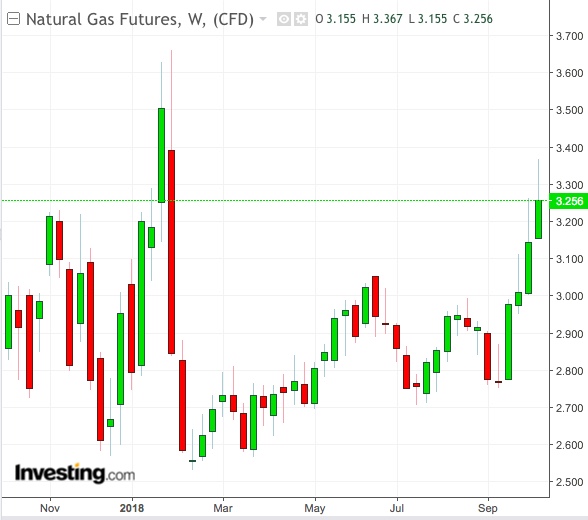The simple answer to the question in the headline is: No one knows.
There is probably as big a constituency that thinks $3 per million British thermal units is the minimum price for natural gas from now till the end of winter next year, as there is one betting for a price crash from the milder weather that typically precedes the cold.
And both sides have facts and data for their convictions.

The bulls are backed by three weeks of settlements at above $3 per mmBtu for gas on the Henry Hub of the New York Mercantile Exchange. They also have the comfort of knowing that the 2018/19 winter will begin with one of the lowest reserves for heating-season gas—making a run towards $4 or beyond very possible in the event of extreme cold.
The bears point to the record highs in gas output since the start of the year, which they said could dramatically add to gas reserves from now—although that had not happened as yet due to a hotter-than-expected summer that forced utility companies to burn more gas to meet the surging demand for electricity from air-conditioner use. They also cite milder weather forecasts over the next couple of weeks that indicate that neither cooling nor heating might be required.
Analysts At A Loss Over Weather And Pricing
Hitting the sweet spot on gas production, weather and pricing has been a challenge to most analysts this year.
Daniel Myers, who forecasts trends and prices for gas at Gelber & Associates in Houston, said weekly injections into storage had remained below the five-year average despite the advent of fall weather—when people should be barely be turning on their air-conditioners. Myers wrote in a commentary on Thursday:
“Although the market has already priced-in the risk of low storage in its recent ascent past $3, continued strong demand that hampers the remaining injections will prevent prices from reverting to the despondent attitude they held much of the spring and summer.”
Before their current run-up, the last time gas prices traded above $3 was in January, during the height of the 2017/18 winter, and briefly in June.
As late as late week, Myers had predicted the possibility of a selloff after the U.S. Energy Information Administration (EIA) announced a build of 98 billion cubic feet in reserves during the week ended September 30—more than double the 46 bcf rise forecast by analysts.
While that huge build got analysts thinking that the warm weather holding over from summer was dissipating, another temperature spike the following week confounded them.
Reuters said in a report that gas consumption was relatively higher last week due to a spike in the number of cooling degree days, or CDDs, which are used to estimate demand for air-conditioning in homes and businesses when a day's average temperature is above 65 degrees Fahrenheit (18 degrees Celsius).
Last week, there were 49 CDDs, versus 36 in the same week a year ago and against a 30-year normal of 30 CDDs for the period.
As a result, most analysts turned conservative in their estimates of last week’s gas injection, agreeing on a consensus of 91 bcf despite some initially projecting beyond 100 bcf. The EIA virtually matched that consensus on Thursday, announcing a build of 90 bcf for last week.
Dominick Chirichella of the Energy Management Institute in New York is also at a loss over the current anomaly in gas pricing, describing the market as “well above its current range support level”.
Just The Beginning Of A Longer Rally?
On the technical front, gas above $3 appears well supported for now. Investing.com has a “Strong Buy” recommendation on NYMEX’s most-active November gas contract, which settled on Thursday at $3.220 per mmBtu. Strongest resistance for the contract is seen at the Level 3 Fibonacci reading of $3.356.
That sort of a target inspires traders such as Mike Seery, who missed the opportunity to get in before the market’s leap to $3, and continues to wait an entry point. “I think this rally is just beginning,” he said.
But Scott Shelton, broker at ICAP) in Durham, North Carolina, has very different view.
“I think this market is a function of CTA-buying,” he said, referring to Commodity Trading Advisors who are usually made up of hedge funds and traders.
Shelton said he anticipated many trades in gas “blowing up in Q4 and Q1”, adding that “unless we get a cold winter, I feel like this is going to end in tears”.
